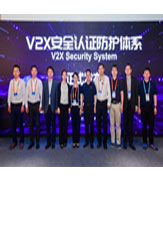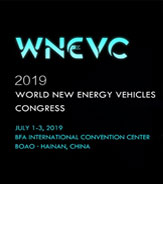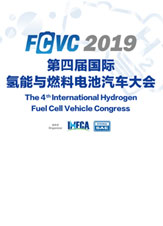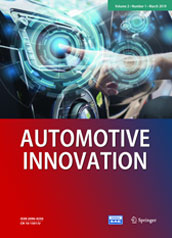

|
The journal Automotive Innovation is sponsored by China SAE, published through Springer, distributed around the world, and reflects the top-level research and technical advance of automotive engineering. Automotive Innovation newsletter in May includes the following contents: 1. A Glimpse of Experts——Prof. Jianbo Zhang from Tsinghua University 2. Article Recommendation——Four papers on technologies of engine, transmission, chassis and car body 3. China SAE News: · Development Trend Report on China Smart Shared Mobility is released |

 Prof. Jianbo Zhang professor of the School of Vehicle and Mobility, Tsinghua University, China |
Research Interests and Expertise Electrochemical power sources for vehicular usage, including thermal management and thermal safety of power lithium-ion battery, deterioration mechanism and life prediction, SOC/SOH estimation, fast charging at low temperature; proton conduction and ORR mechanism on Pt surface, behavior of super-cooled water during sub-freeze startup, deterioration mechanism and durability of fuel cell; theory and application of electrochemical impedance spectroscopy, etc. |
||
|
Profile Prof. Jianbo Zhang is a professor in the School of Vehicle and Mobility, Tsinghua University, China. He graduated from Tsinghua University in 1990, and received his doctorate from Tokyo University in 2000, and then worked in Japan for more than ten years. Pioneering achievements have been made by him in the field of fuel cell water management. An electrochemical Laboratory for catalyst research with high precision instruments has been established when he worked in Nissan. In 2011, he returned to Tsinghua University and founded the Lab of Electrochemical Power Sources. His research interests focus on the diagnostics and design of electrochemical devices such as the fuel cells and lithium-ion cells. The study on fuel cells includes the electron-spun and ordered catalyst layer, low Pt-loading and high power density stack design, and sub-zero start-up, etc., while the study on lithium-ion cells includes the design theory of electrodes and the cell, the quick charging from sub-zero, and the degradation diagnostics and prognostics, etc. He published many papers that were indexed in SCI, and authored the book The Theory and Application of the Structure Design for Lithium-Ion Batteries (in Chinese). He is a member of the Scientific Committee of European Fuel Cell Forum, a member of the International Symposium of Electrochemical Impedance Spectroscopy, and an editor for Automotive Innovation(the first English journal in China automotive industry) and the Battery journal. |
|||

   
|
Comparative Study on the Temperature Rise of a Dry Dual Clutch Under Different Starting Conditions Maotao Zhu, Peng Yao, Yubin Pu, Tao Liu |
||
| A finite element model of the pressure plate and friction plate of the dry dual clutch is established to find the temperature rise of a dry double clutch in operation. Different starting conditions for the temperature of the dry dual clutch are obtained by calculating the temperature rise, and a comparative analysis of the results is conducted. Results show that the temperature rise for clutch 2 is generally higher than that for clutch 1. And the temperature rise of clutch 2 is higher than that of clutch 1, with an increasing throttle opening. A curve of the speed difference between engine and friction plates is extracted by calculating the source power of the wear of the sliding mill. It is found that the clutch speed difference of clutch 2 is generally higher than that of clutch 1 because clutch 1 follows a constant-rotation-speed control strategy at the start of grinding, leading to the temperature rise of clutch 2 being greater than that of clutch 1. A constant-engine-speed shift strategy is finally put forward. | |||
|
Keywords: Dry double clutch · Friction power · Temperature field · Comparative analysis · Speed difference Zhu, M., Yao, P., Pu, Y.,et al.: Comparative Study on the Temperature Rise of a Dry Dual Clutch Under Different Starting Conditions. Automotive Innovation 2(1), 35-44(2019) |
|||
| Full Paper Reading>> | |||
   
|
Gasoline Engine Operating Under Negative Valve Overlap Strategy Huanchun Gong |
||
| To meet the requirements of the homogeneous charge compression ignition gasoline engine's rapid cylinder exhaust gas rate and accurate control of combustion phasing, a residual exhaust gas rate model was proposed. A heat dissipation model for gas flow in the exhaust passage and exhaust pipe was established, and the exhaust gas was established. Flow through the exhaust valve was considered as an adiabatic expansion process, the exhaust temperature was used to estimate the temperature in the cylinder at the time that the valve was closed, and the cylinder exhaust gas rate was calculated. To meet the requirements of transient operating conditions, a first-order inertial link was used to correct the thermocouple temperature measurement. Addressing this delay problem and modification of the exhaust wall temperature according to different conditions, effectively improved the accuracy of the model. The relative error between the calculated results of this model and the simulation results determined using GT-POWER software was within 3.5 %. | |||
|
Keywords: Residual exhaust gas · Negative valve overlap angle · Homogeneous charge · compression ignition · Gasoline engine · Numerical estimation Gong, H.: Estimation of Residual Exhaust Gas of Homogeneous Charge Compression Ignition Gasoline Engine Operating Under Negative Valve Overlap Strategy. Automotive Innovation 2(1), 45-54(2019) |
|||
| Full Paper Reading>> | |||
   
|
Optimization of Torsional Stiffness for Heavy Commercial Vehicle Chassis Frame S. H. Gawande, A. A. Muley, R. N. Yerrawar |
||
| The chassis frame is the backbone of a heavy commercial vehicle (HCV). Its main purpose is to securely carry the determinedload under all designed operative situations. Thus, it should be rigid enough to withstand the various forces acting on it. The objective of this study was to develop a stiffness model to select an optimum cross section with determined torsional stiffness. Johnson’s method of optimization was adapted to develop a stiffness equation and select a section with a determined torsional stiffness and a required mass constraint. The stiffness obtained from the developed stiffness model and finite element analysis (FEA) is a close match, which proves the validity of the proposed model. The section with the maximum torsional stiffness was used for frame-level optimization to improve the torsional and lateral stiffness of the overall chassis frame. The strain energy absorption capacity of the cross member improved by changing the section of the cross member. By using the optimized section, the torsional stiffness of the frame improved by 44% and a lateral stiffness of 10% was obtained. The Creo software was used for modeling and FEA was performed with the Hypermesh software. | |||
|
Keywords: Chassis frame · Torsional stiffness · FEA · Cross members · Deformation Gawande, S. H., MuleyR, A. A., Yerrawar, N.: Optimization of Torsional Stiffness for Heavy Commercial Vehicle Chassis Frame. Automotive Innovation 1(4), 352-361(2018) |
|||
| Full Paper Reading>> | |||
   
|
Uncertainty Optimization Design of a Vehicle Body Structure Considering Random Deviations Jianhua Zhou, Fengchong Lan, Jiqing Chen, Fanjie Lai |
||
| In vehicle body manufacturing, there are small differences between the actual value and design value of, for example, plate thickness and material characteristics. This is caused by the processing technology, environment and other uncertain factors. Therefore, the performance of the vehicle body processed according to the deterministic optimization solution fluctuates. The fluctuations may make structural performance fail to meet the design requirements. Thus, in this study, an optimization design is executed with 6σ robustness criteria and a Monte Carlo simulation single-loop optimization strategy based on the radial basis function neural network approximate model considering deviations in plate thickness, elastic modulus, and welding spot diameter, which is called the uncertainty optimization design method. As an example, considering the bending stiffness, torsion stiffness, and first-order frequency as constraints, the method is applied to the lightweight design of a car body structure, and the reliability of deterministic optimization design and uncertainty optimization design is compared. The results demonstrate that the uncertainty optimization design solution is effective and feasible without lowering the static stiffness and modal performance, and the weight is reduced. | |||
|
Keywords: Body structure · Lightweight · Approximate models · 6 robustness criteria · MCS single-loop optimization strategy Zhou, J., Feng, L., Chen, J., et al.: Uncertainty Optimization Design of a Vehicle Body Structure Considering Random Deviations. Automotive Innovation 1(4), 342-351(2018) |
|||
| Full Paper Reading>> | |||

 |
|||
| Development Trend Report on China Smart Shared Mobility is released | |||
|
Development Trend Report on China Smart Shared Mobility, released by China SAE in May, is one of the earliest important reports on the development trend of smart shared mobility in China. This study analyzes the current development of smart shared mobility, and demonstrates the key factors affecting the proportion of shared mileage, including travel cost, platform service reliability and the influencing mechanism. Based on the analysis of influencing factors, and combined with the development of automated driving and new energy vehicle technology, it predicts the development trend of future smart shared mobility, and gives some development suggestions.
Download the report (in Chinese) |
|||
 |
|||
| V2X Security System is released | |||
|
The LTE-V2X commercialization route and time point are gradually clarified, and the security requirements of V2V direct communication are more prominent. On the one hand, V2X mostly transmit real-time information about road emergency, congestion and traffic accidents. The information should be sent out by legitimate equipment and has not been tampered or replayed; on the other hand, when identifying vehicles, it is necessary to avoid leakage of user privacy caused by direct use of the vehicle or the owner's information. To realize the V2X direct communication function in vehicles, CICV(China Intelligent and Connected Vehicles Research Institute) has cooperated with a number of scientific research institutions, three major TELCOMs, domestic and foreign vehicle manufacturers and intelligent and connected vehicle enterprises, and jointly released the V2X Security System on May 30, 2019. Considering the high mobility and low latency requirements for V2X communication, this system fully balances information integrity, authenticity protection and privacy protection, and realizes the V2X security certification. |
|||
 |
|||
| The World New Energy Vehicle Congress (WNEVC): registration is open | |||
|
Approved by the State Council of the People's Republic of China, the WNEVC 2019, hosted by CAST and Hainan Provincial People's Government, will be held in Boao, Hainan Province from July 1 to 3, 2019. WNEVC, focusing on the transformation and upgrading of the automotive industry and ecological environment improvement, will bring together global experts and industry elites to share their insights and discuss development trends and innovations of NEVs, such as technologies, industry ecosystem, government policies and business models. It also aims to build industry consensus, clarify growth direction, and identify effective pathway of integrated development of electrification, intelligence, connectivity and shared mobility.
The preliminary agenda is available and registration is now open. Registration online |
|||
 |
|||
| The 4th International Hydrogen Fuel Cell Vehicle Congress (FCVC 2019): registration is open | |||
|
The 4th International Hydrogen Fuel Cell Vehicle Congress (FCVC 2019) will be held on Sept. 26-28, 2019 in Rugao, China. With the model of combination of conference and exhibition, FCVC 2019 will include plenary Session, academician forum and technical sessions, and focus on the hydrogen fuel cell applications, hydrogen generation & storage, fuel cell stacks & components, standards & testing, hydrogen stations & infrastructure, and market & capital investment as well. The test ride and technical exhibition will also be organized during it. About 1,500 delegates and 80 exhibitors are expected to attend FCVC 2019.
The registration is now open. Registration online |
|||

|
Automotive Innovation Automotive Innovation is the first English journal in China's automotive industry. Founded in 2018, sponsored by China SAE and published via Springer, Automotive Innovation has a very special significance in China's automotive academia. Since its inauguration, world-renowned automotive experts with high H index have been invited to join the editorial board, and the strict standards of SCI Journals are meticulously followed to ensure the high quality of papers and publication. By now, five issues have been published successfully with readers in 72 countries and regions. Many famous professors have already published articles in it, such as Prof. Liguang Li, Prof. Shijin Shuai, Prof. Ferit Küçükay, Prof. Xiangyang Xu, Prof. Amir Khajepour and so on. The journal has been recognized by FISITA, other international organizations and some well-known universities. Editors-in-Chief Jun Li, Academician of CAE, President of China SAE, Professor of Tsinghua University Frank Zhao, President (2018-2020) of FISITA, President of Tsinghua Automotive Strategy Research Institute Executive Editor-in-Chief Prof. Mike Ma,Executive Chief Editor of Automotive Innovation, Professor of Jilin University, VP Technical FISITA |
||||
|
Paper submission and browse www.ChinaSAEJournal.com.cn www.springer.com/42154 Contacts: Ms. Huisi, Gu Tel: +86-10-50950101 Email: ghs@sae-china.org |

|
|||
|
Sponsored |
Co-operated with
|
|||